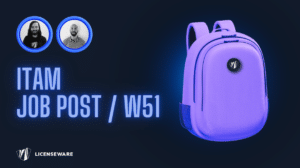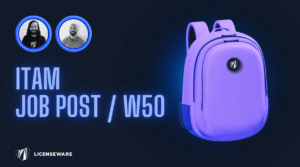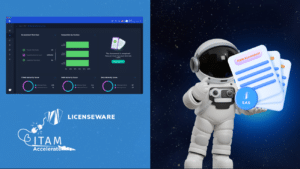The Next Frontier of SAM: Your Next Asset Class Will Be a Robot

For decades, Software Asset Management (SAM) professionals have wrestled with an ever-expanding list of assets. From physical servers in the data center to virtual machines, cloud instances, and user-based subscriptions, the definition of a “software asset” has constantly evolved. Now, a glimpse of the next great leap is emerging, and it has two legs. The recent discourse around Tesla’s Optimus robot and its potential business model offers a fascinating preview of a future where SAM teams will add humanoid robots to their asset registers, licensed not by the core or the user, but by the function.
The conversation was sparked by Elon Musk’s projection of Tesla’s ambitions for its Optimus robot. While the high-level revenue figures were astronomical, a more insightful exchange on X.com (formerly Twitter) drilled down into the potential business model, providing a plausible blueprint for how this new asset class will be commercialized.¹ The speculation, put forth by user @Rec1pr0city, suggested that the true value isn’t in the initial hardware sale, but in the recurring revenue streams that follow. The theory posits a model where a customer might pay a relatively low upfront cost for the physical robot – say, $10,000 – but the majority of the lifetime value comes from a mandatory monthly software license, perhaps $1,000, along with maintenance contracts and warranties.¹
This is the moment where the future of Software Asset Management snaps into focus. The robot itself is not the product; it is a mobile, general-purpose hardware platform. The product is the software that gives it utility, capability, and intelligence. The robot is merely the vessel for the license.
The Anatomy of a Robot License
This “Hardware as a Service” (HaaS) model, driven by software licensing, fundamentally changes how organizations will procure, manage, and account for robotic assets. Based on the Tesla speculation and current enterprise software trends, we can envision a complex, multi-layered licensing framework that SAM teams will need to master.
1. The Base Subscription (The “Right-to-Operate” License):
This would be the mandatory, recurring fee, as suggested in the X.com discussion.¹ This license doesn’t just activate the robot; it provides access to the core AI, continuous learning updates from the fleet, security patches, and basic operational capabilities. Without this license, the $10,000 hardware is little more than a sophisticated paperweight. This is the foundational layer of the robot’s value.
2. Tiered Capability Modules (Functionality-as-a-Service):
Beyond the base license, vendors like Tesla will almost certainly offer tiered software packages based on specific job functions. A robot’s utility in a warehouse is vastly different from its role in a hospital or a restaurant. We can expect to see licensing bundles such as:
- “Logistics & Warehousing” Tier: Unlocks capabilities for palletizing, package sorting, and inventory management.
- “Healthcare Support” Tier: Enables patient mobility assistance, supply delivery, and sanitation routines, likely with stricter compliance and security protocols.
- “Hospitality” Tier: Provides modules for food service, bussing tables, and customer interaction.
Each tier would be a separate, stackable license, allowing businesses to customize a robot’s skillset to their specific needs.
3. Consumption-Based Licensing (Pay-per-Task):
For businesses with variable needs, a consumption or metered model is highly likely. This could be measured in several ways:
- Hours of Operation: A simple model where a business pays for the number of hours the robot is active.
- Tasks Completed: A more granular model where the license fee is tied to specific outcomes, such as the number of boxes moved, rooms cleaned, or components assembled.
- Data Processed: For robots involved in inspection or analysis, licensing could be tied to the volume of data its sensors capture and process.
The New SAM is all About Managing Software on Legs
This future presents a profound new challenge for SAM. The asset register will now include physical, mobile endpoints whose compliance status is determined by the tasks they are performing in the physical world. The key challenges will include:
- Blending of HAM and SAM: The line between Hardware Asset Management and Software Asset Management will completely dissolve. Tracking the physical location, maintenance status, and hardware configuration of a robot will be inseparable from managing its software entitlements.
- Functional Compliance: Audits will no longer be about counting cores or users. A vendor could audit a company to ensure a robot licensed for “Warehouse Logistics” is not being used to perform tasks from the more expensive “Healthcare Support” module. This requires a completely new set of monitoring and governance tools.
- Forecasting and Optimization: In a consumption-based model, predicting costs will become a major focus. SAM teams will need to analyze usage patterns to determine if a fixed-tier license is more cost-effective than paying per task, much like they do today with cloud services.
The conversation around the Optimus robot’s pricing is more than idle speculation; it is a clear signal of where the market for intelligent automation is headed. The value is migrating from the physical shell to the intelligent software within. For the world of Software Asset Management, the preparation must start now. The next asset you are asked to track may not be in a data center or on a desktop, but walking down your hallway.
Sources
- @Rec1pr0city via X.com (July 27, 2025) https://x.com/Orgasamistt/status/1947395230095053215










